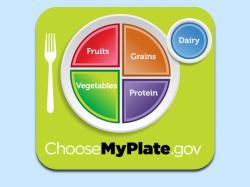Beef: An Essential Building Block For Enjoying A Plate
June 6, 2011 | 3 min to read

WASHINGTON — The new visual icon released today by the U.S. Department of Agriculture (USDA) and the Department of Health and Human Services (HHS), called MyPlate, offers simple and actionable steps to build healthier diets. This straightforward visual gets back to the basics, illustrating how to create a healthful plate with a balanced mix of nutrition from a variety of foods. Recognized by the 2010 Dietary Guidelines Advisory Committee as a nutrient-dense food, lean meats – including lean beef – make it easier to "enjoy our food, but eat less" as the 2010 Dietary Guidelines for Americans encourage.(i) In fact, there are more than 29 cuts of beef that meet government guidelines for lean including Sirloin, Tenderloin, T-Bone steak and 95 percent lean Ground Beef, so it is easy for Americans to enjoy a variety of healthful meals that include nutrient-rich lean beef. And, because 67 percent of all beef muscle cuts sold at retail are lean, many consumers are already choosing lean cuts for themselves and their families. (ii)
"More than 90 percent of Americans already enjoy the taste of beef. And now with the knowledge of how lean beef fits perfectly into the Dietary Guidelines recommendations and graphic, they have even more reasons to enjoy it and feel good about it," said Shalene McNeill, PhD, RD, executive director of human nutrition research, National Cattlemen's Beef Association, which contracts to manage programs for The Beef Checkoff. "More significantly, nutrient-rich lean beef is an essential building block for building a satisfying and healthy plate that's full of great taste and good nutrition. Just one 3-ounce serving of lean beef supplies nearly half of the Daily Value for protein, plus nine other essential nutrients, in about 150 calories.(iii)"
In fact, research suggests that including lean beef in a heart-healthy diet provides more variety to the diet, which can help improve long-term adherence.(iv)
Research also shows that enjoying lean beef as part of a balanced diet is associated with improved overall nutrient intake, diet quality and positive health outcomes. (v, vi) Lean beef provides essential nutrients like protein, zinc, iron and Vitamin B12 – plant foods are not naturally good sources of these
nutrients. Easily paired with and nutritionally complementary to vegetables, fruits, grains and dairy, lean beef provides 10 essential nutrients that help Americans build healthier diets. By adding lean beef to a favorite salad, stir-fry, or vegetable-rich casserole, Americans can create satisfying meals that also help build a plate with half of it full of fruits and vegetables.
America's farmers and ranchers, through the Beef Checkoff, look forward to helping families incorporate this tool into their lifestyles, as part of their long-standing commitment to help Americans build healthier diets with lean beef. Please visit BeefItsWhatsForDinner.com to learn more about the favorite lean cuts of beef, find delicious recipes and discover how to lean on beef to build a healthful plate that meets the 2010 Dietary Guidelines recommendations.
About the Beef Checkoff
The Beef Checkoff Program was established as part of the 1985 Farm Bill. The Checkoff assesses $1 per head on the sale of live domestic and imported cattle, in addition to a comparable assessment on imported beef and beef products. States retain up to 50 cents on the dollar and forward the other 50 cents per head to the Cattlemen's Beef Promotion and Research Board, which administers the national Checkoff program, subject to USDA approval.
About the National Cattlemen's Beef Association
The National Cattlemen's Beef Association is a contractor to the national Beef Checkoff Program, which is administered by the Cattlemen's Beef Board. Consumer-focused and producer-directed, NCBA and its state beef council partners work together as a marketing organization on behalf of the largest segment of the food and fiber industry.
i U.S. Department of Agriculture and U.S. Department of Health and Human Services. Dietary Guidelines for Americans, 2010. 7th Edition, Washington, DC: U.S. Government Printing Office, December 2010.
ii Freshlook Marketing Group, the leading U.S. source of grocery scanner data for meat and produce purchasing, 52 weeks ending 11/21/10.
iii USDA National Nutrient Database for Standard Reference, Release 23, 2010.
iv Paddon-Jones D,et al. Protein, weight management, and satiety. American Journal of Clinical Nutrition 87 (2008) 1558S-1561S.
v O’Neil CE, et al. Nutrient contribution of total and lean beef in diets of U.S. children and adolescents: National Health and Nutrition Examination Survey 19992004. Meat Science 87 (2011) 250–256.
vi Zanovec M, et al. Lean beef contributes significant amounts of key nutrients to the diets of U.S. adults: National Health and Nutrition Examination Survey 19992004. Nutrition Research 30 (2010) 375381.
Source: National Cattlemen's Beef Association
